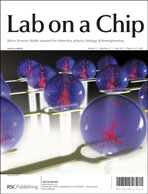For tissue engineering and regenerative medicine, cryopreservation, a technique for preserving biomaterials in the frozen state with cryoprotective agents (CPAs), is critically important for preserving engineered tissues (ETs) as well as cells necessary to create ETs. As more diverse ETs are produced using various cell types, CPAs and corresponding freeze/thaw (F/T) protocols need to be developed cell/tissue-type specifically. This is because CPAs and F/T protocols that have been successful for one cell/tissue type have proven to be difficult to adapt to other cell/tissue types. The most critical barrier to address this challenge is the inability to screen and identify CPA or CPA mixtures efficiently. In this paper, we developed an “electro-wetting-on-dielectic” (EWOD) based digital microfluidic platform to characterize and screen CPA mixtures cell-type specifically. The feasibility of the EWOD platform was demonstrated by characterizing and optimizing a mixture of dimethlysulfoxide (DMSO) and PBS for human breast cancer cell line as model CPA mixture and cell line. The developed platform multiplexed droplets of DMSO and PBS to create an array of DMSO-PBS mixtures, and mapped the phase change diagram of the mixture. After loading cell suspensions on the platform, the mixture was further screened on-chip for toxicity and cryoprotection. The results were discussed to illustrate the capabilities and limitations of the EWOD platform for cell and tissue-type specific optimization of CPA mixtures and F/T protocols.

You have access to this article
 Please wait while we load your content...
Something went wrong. Try again?
Please wait while we load your content...
Something went wrong. Try again?


 Please wait while we load your content...
Please wait while we load your content...